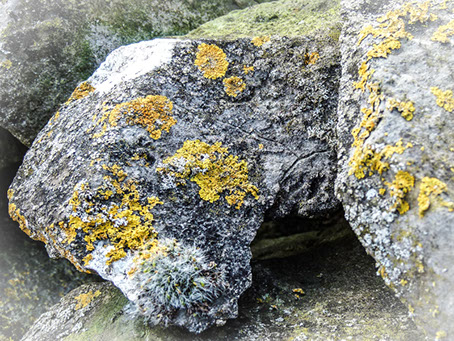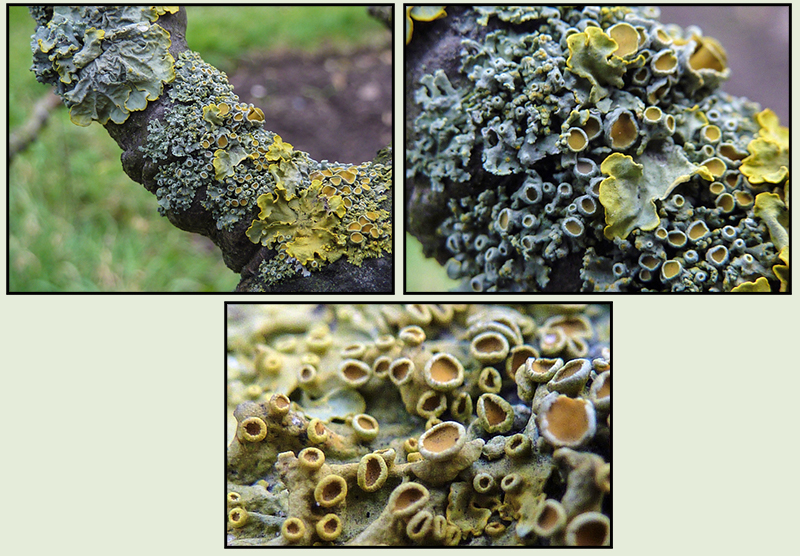

Home
About Us
Garden Diary
Weather Diary
Allotments
Garden Equipment
Seed Suppliers
Manure Problems
Children's Pages
GLA Blog
Weather Blog
School Veg Patch
Useful Links
Wild Flowers & Plants
We have lots of lichens growing on tree bark, stone and other surfaces on our plot and in our garden so I decided to try and find out more about them.
The first thing I found out was that any information on lichens is littered with complicated and, in many cases, unpronounceable words. People even argue about how to pronounce the word lichen (I say liken but another accepted pronunciation is litchen).
Lichen isn’t the name of one plant but of two or three plants living together in partnership – a sort of marriage of plants. One of the partners is a fungus and the other one or two are algae or bacteria. The plants create a type of partnership called symbiosis. Each partner carries out an essential function and no partner could survive without the other or others.
In Britain alone there are over 1,700 different types of lichen which belong to one of three main types.
1. Crusty or crustose lichen spread over the surface of their habitat. They grow flat against the surface and are difficult remove without crumbling. Many of these grow on rocky surfaces.

2. Leafy or foliose lichen are often found on trees or the ground and have a circular lobed growth pattern and are attached to the surface of their habitat with tiny root like threads. Although they look like roots their only function is to hold the lichen in place. The lobes often swell when they are wet. They can easily be detached from the surface using a knife.

3. Shrubby or fructicose lichen are branched and as the name suggests shrub-like. They either grow up from the ground or hang down like a beard. They don’t posses root like threads and can easily be removed from their growing surface by hand.

Often identification of lichens is only possible using a microscope so I am not even going to attempt to identify then. If you want to find out more about identifying lichen click here - I’ll just enjoy them.
Although lichens have no leaves, stems or roots, they produce their own food using energy from sunlight. This is possible due to one partner – the alga - containing chlorophyll, (the green colouring in leaves that absorbs sunlight). This enables lichen to produce food in the same way as a plant with green leaves does. The role of the fungus partner is to soak up water and nutrients. It also provides shelter to the alga and the means by which the lichen reproduces. Each member of the partnership benefits from the ‘abilities’ of the other.
Lichens grow in places that would otherwise be plant-less due to conditions being too hot, too dry, too cold (lichens have been found in the Arctic) or just lacking in nutrients. Lichens absorb water and minerals from rainwater directly from the atmosphere and so can be found on just about any solid surface including decaying wood, tree bark, bare rock and concrete. Some are even unattached and blow around in the wind. Where lichens grow in otherwise barren locations they provide shelter and food for creatures such as mites, molluscs, spiders and moths which in turn provide food for creatures higher up the food chain.
As lichens absorb moisture from the atmosphere, during dry conditions they will become dormant. Lichens living on tree bark will also be shaded from the sunshine by leaves during the summer months and therefore less able to produce food. Once leaves fall from the trees sunlight will reach the lichens and they will benefit from the damper, lighter (for them) conditions that winter provides. In this way the trees and lichens can grow in harmony with no harm being done to either of them.

Woodlands where lichens are found in abundance have been seen to be far richer in wildlife with many small birds using fragments of lichen to camouflage their nests. Lichens also help to break down dead wood and in so doing release nutrients back into the soil.
Lichens may reproduce in a couple of ways – the simplest method is where a piece of lichen breaks off and grows into a new plant. The second way is where the fungus part of the lichen produces spores. The spores can only reproduce the fungal part of the lichen and will only form new complete lichen if they happen to join with a suitable alga with which to form a partnership. If this doesn’t happen the germinated fungus will die as it doesn’t possess the ability to survive on its own.
As lichens obtain their moisture and nutrients from the air they are sensitive to air pollution. Different species of lichen are more tolerant of pollution than others so analysis of the types of lichens found in a location can produce a good indication of the level of atmospheric pollution.
The growth rate of lichens can in some species be as little as 1 mm per year. Lichen growth has been used to as a method of determining the age of surfaces on which the lichen is growing. Some lichens have been estimated at 9000 years old. (Just imagine the stories that they could tell)!
Other uses of lichens over the years include:
- in the production of some antibiotic drugs.
- to produce dyes for cloth and litmus dye which is used as a PH indicator.
- as packaging for Egyptian mummies. (Although there isn't much call for this nowadays)!
For little plants that are often overlooked lichens are good things to have around even if we can’t agree how to pronounce their name.
Our Plot at Green Lane Allotments Blog | A Gardener's Weather Diary | School Vegetable Patch Website
© Our Plot on Green Lane Allotments - Please email me if you wish to use any of this site's content